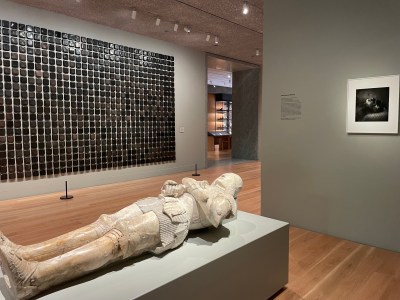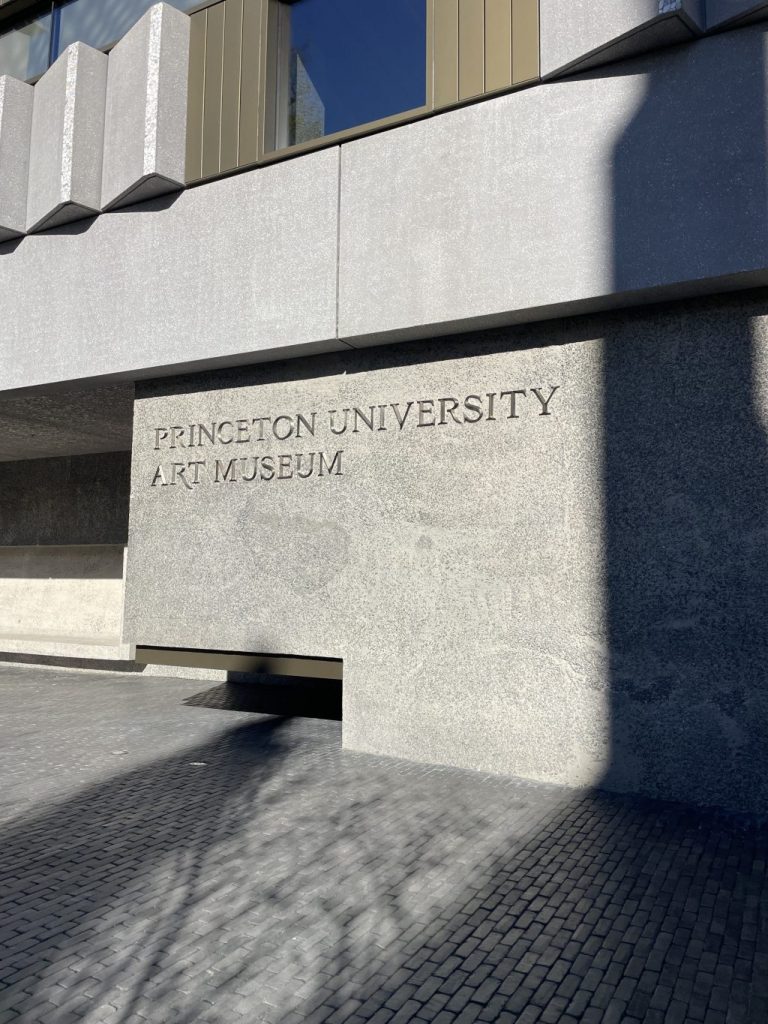The Princeton University Art Museum (PUAM) reopened its doors to the public Friday, after an almost six-year hiatus. Its previous home, last updated in 1969, was demolished in 2021 to make room for a new 146,000-square-foot complex, which was designed by Adjaye Associates.
Walking through Princeton University’s historic campus on my way to PUAM, as crisp leaves fell from their branches, I felt transported to the East Coast collegiate quad that an Ivy League like Princeton typically conjures. That sentiment, however, that did not immediately translate when I reached the new PUAM. It’s hard to miss—obtrusive even. I was struck by how modern the building was in contrast to the surrounding older structures. Walking down its steps into the heart of the building felt like entering the belly of the beast, a kind of sepulcher. A 40-foot-tall colorful, abstract mosaic by Nick Cave, made to resemble one of his iconic “Soundsuits” didn’t help much to assuage those somber feelings.
The building itself, featuring nine interlocking modernist pavilions in stone aggregate, has its own knotty history. When allegations of sexual misconduct against David Adjaye, the principal of Adjaye Associates, surfaced in 2023, the building was already more than half-way completed. Though the celebrated Ghanaian British architect has denied those accusations, he stepped back from his work at PUAM, among other projects—a point the museum’s leadership briefly made during a recent press briefing ahead of the building’s public opening.
Though my initial read of the space seemed cold, this feeling, luckily, did not last. In fact, the longer I spent at PUAM the more an opposing sentiment washed over me. Visitors can enter the museum from any of its four sides, making it a mere 10-minute walk from each of Princeton’s on-campus residence halls—a reflection of its openness and accessibility.
But despite its upgraded size, the redesigned museum never felt daunting. There’s something intimate about how the installation of its collection—one of the oldest in the country and now numbering around 2,000 objects—has been realized. Located in central New Jersey, between Manhattan and Philadelphia, PUAM now has the footprint to match its ambition of being a leading museum for its students and the community at large.
The new PUAM building is, in fact, quite long, connected via two interior “artwalks.” At its center is an open hall that is typically furnished with comfortable seating and couches, but can be converted into lecture hall or performance space, with retractible seating and walls for additional privacy.
From the two adjoining artwalks, visitors can see three stories of built-in shelves lined with various art objects, from an abstract work that Frank Stella painted in 1958, the year he graduated from the university, to an Ancient Roman mosaic floor that was excavated by Princeton archaeologists in Türkiye during the 1930s.
Much of the museum’s current curation incorporates this kind of ahistorical abutment—pairing together seemingly disparate works to tell a new kind of story. Other examples include Andy Warhol’s Blue Marilyn (1962) next to Giovanni di Tano Fei’s Virgin and Child (late 14th century) as a way to think about different forms of iconography and worship, or the juxtaposition in one gallery of Titus Kaphar’s To Be Sold (2018), a Charles Wilson Peale portrait of George Washington (ca. 1787), and a Nkisi (power figure) from the early 20th century to an unattributed Kongo artist.

Interview view of Princeton University Art Museum , 2025. In the foreground lies Gisant: knight in armor, ca. 1500, by an unidentified artist; in the background from left to right is Teresa Margolles’ El manto negro (The Black Shroud), 2020, and Sally Mann’s Was Ever Love (2009).
Photo Francesca Aton / ARTnews
One particularly striking section focuses on different representations of grief, bringing together the life-size horizontal stone statue Gisant: knight in armor (ca. 1500) by an unidentified artist; Sally Mann’s photograph of her ailing husband, titled Was Ever Love (2009); El manto negro (The Black Shroud), a 2020 ceramic installation by Teresa Margolles; and Christian Boltanski’s mixed-media installation featuring found photographs of Jewish students prior to the Nazi annexation of Austria. The profound care with which these objects were made undergird life’s most profound loves—and losses.
These works and others, like those by contemporary art stars Gerhard Richter, Diana Al-Hadid, Sean Scully, and Rose B. Simpson, form the basis of the 150-work exhibition “Princeton Collects,” which takes over the second floor galleries and is on view until next March. Also on view is “Toshiko Takaezu: Dialogues in Clay,” which highlights PUAM’s deep holdings of the ceramicist, who taught at Princeton for more than 20 years.
As I continued to walk through its galleries, PUAM seemed to just keep going, with seemingly no end in sight—not a bad thing for a museum of this size. It sparked in me a frenzied moment of obsession to cram in as much viewing as I could. To really see everything on view its current display, visitors should on plan on more than a few hours.
Near the end of the my visit, I stumbled on a conservation lab, tucked away from the galleries yet seamlessly integrated into the museum at large. The lab, along with several classrooms on the first floor, is one of many spaces dedicated to object-based learning opportunities for Princeton’s students. Princeton has long offered art conservation classes, cross-listed for multiple majors, but until now, due to spatial constraints, these classes were held in a separate building. Now all this learning can happen in one unified building.



